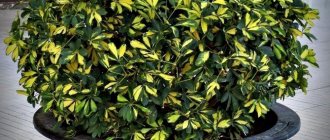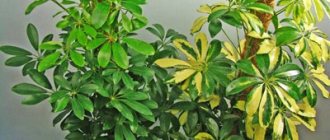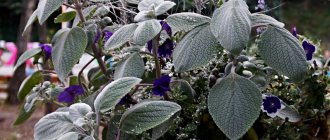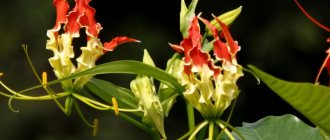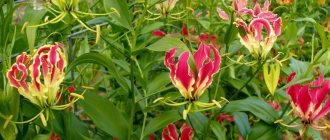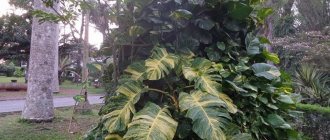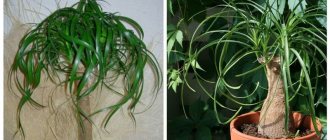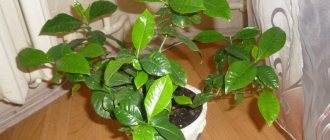Author: Elena N. https://floristics.info/ru/index.php?option=com_contact&view=contact&id=19 Category: Houseplants Published: February 24, 2019Last edits: January 11, 2021
- Reproduction methods
- Schefflera turns yellow
- Schefflera octophylla (Schefflera octophylla)
plant (lat. Shefflera) , or shefflera , or umbrella tree , belongs to the largest genus of plants in the Araliaceae family, numbering about 200 species. The Schefflera flower received its name either in honor of the German botanist Jacob Christian Scheffler, who lived in the 18th century, or in honor of the Polish scientist Peter Ernest Jan Scheffler. In nature, representatives of this genus are vines, shrubs or trees, reaching a height of two and a half meters and growing in the tropics of Australia, Southeast Asia and the Pacific Islands. Some garden forms of shefflera with variegated foliage are in demand in culture; shefflera was grown in the house relatively recently. This is an exotic relaxation plant that absorbs negative energy like a sponge, saturates the air with oxygen and increases its humidity.
Planting and caring for cheflera
- Flowering: the plant is grown as an ornamental foliage plant.
- Lighting: bright light in the first half of the day, bright diffused light or light partial shade in the second (eastern and western window sills). You can keep the sheflera near the south window, but behind a light curtain. Variegated varieties are more light-loving than forms with monochrome leaves.
- Temperature: during the growing season - normal for residential premises, in winter - 16-18 ˚C, lower temperature threshold - 12 ˚C.
- Watering: regular, moderate, rare during cool winters.
- Air humidity: above average. It is recommended to spray the leaves with warm soft water, especially in hot weather and during wintering in a warm room.
- Fertilizing: from March to August 2-3 times a month with complex fertilizer for decorative deciduous crops. The rest of the time, no fertilizing is applied.
- Dormant period: from September to February.
- Transplantation: young plants are replanted annually, adults - as needed. Transplantation is carried out in the spring, at the beginning of active growth.
- Reproduction: seeds, air layering and cuttings.
- Pests: aphids, thrips, scale insects, spider mites.
- Diseases: from chronic waterlogging of the soil - root rot, due to poor care - loss of decorative qualities.
Read more about growing sheflera below.
Trimming
Often, to make shefflera look as lush as in the photographs, several plants are planted in one pot at once. In addition, the flexible trunks of young plants can be woven into shapes, as long as this can be done without breaking. And in order for the shefflera bush to form a neat crown, it is pruned. True, the plant must be pruned correctly, otherwise it will suffer.
Schefflers also perform low pruning in case of almost complete fall of leaves due to improper care. True, saving a plant by pruning is possible only if the root system is healthy. The remaining stumps should be watered regularly, soon the plant will rejuvenate and new shoots will appear on it.
Botanical description
Scheffler's home flower is an ornamental foliage plant with palmately dissected leaves with 4-12 lobes, which look like a palm with outstretched fingers, solid green or variegated colors with yellow or white spots and streaks. Schefflera's inflorescences are elongated, racemose, tentacle-like, but you are unlikely to be lucky enough to see them, since the plant blooms only in nature or in a botanical garden. Typically, an indoor sheflera is formed in the form of a tree, like Ficus Benjamin, or in the form of a bush. The shoots of the plant are thin, so when growing into one trunk it must be attached to a support.
Schefflera is relatively unpretentious, so it will not be difficult to grow it even for a novice gardener, but it should be remembered that the plant contains substances that irritate the skin and mucous membrane, so care must be taken when caring for it.
General information
The indoor Schefflera flower belongs to the Araliaceae. In nature, its representatives settle in Australia, Japan, and China. Among the genus Scheffler, which has about 600 species, there are mainly low trees, shrubs, and sometimes vines. Wild species can reach 2 m, indoor species are much lower. The leaves are of decorative value: complex, divided into several lobes, sitting on long petioles. Because of their shape, Schefflera is popularly called the “umbrella tree.” The trunk of young plants is leafy, becoming bare with age.
Blooms only in natural conditions. The inflorescences are elongated, racemose, reminiscent of tentacles. This is why natural varieties are called “octopus trees.” All parts of Schefflera are poisonous.
Caring for sheflera at home
Growing conditions
Schefflera is a light-loving plant, so it is placed on a southern, western or eastern windowsill, but during periods of too much sun activity, the plant is covered from direct rays with a light curtain. If you have already received an adult large sheflera, install it near the south window in close proximity to the curtains. In an apartment where there is little light, you should not grow variegated varieties, since they are more light-loving than shefleras with green leaves: due to lack of lighting, variegated leaves become monochromatic.
- What flowers to take outside
In summer, sheflera takes well to outdoor holidays in light partial shade, protected from wind and drafts.
The air humidity in the room where the cheflera is located should be above average, and although the plant easily adapts to room conditions, daily spraying with settled water will have a beneficial effect on it. When dust accumulates on sheflera leaves, it is advisable to give it a shower or wipe the leaves with a damp sponge.
In winter, when heating devices are working in the apartment, the sheflera is placed on a tray with wet expanded clay or pebbles, but in such a way that the roots of the plant do not touch the water. As for the temperature, in the summer the cheflera feels normal at the usual temperature for this time, but in the winter she is more comfortable in conditions of 16-18 ºC, the lower limit of winter temperature for the plant is 12 ºC.
Water the sheflera with settled water, preventing the earthen clod from drying out. However, you should refrain from too frequent and abundant watering, which can lead to acidification of the soil and rotting of the roots. The water temperature for watering the cheflera should be the same as the temperature in the room, or a couple of degrees warmer.
Transfer
It is advisable to replant young plants annually in the spring, and adult plants once every few years, as the pot fills with roots. Take a container 5-6 centimeters in diameter larger than the previous pot. Before replanting the shefflera, place a thick layer of drainage in the pot, which will prevent water from stagnating in the roots.
The soil for sheflera requires light, permeable, but at the same time fertile. A soil mixture of three parts compost soil, one part fibrous peat and one and a half parts coarse sand is best suited to the tastes of sheflera, although universal store-bought soil or soil for palm trees will also work. Carefully transfer the shefflera along with the earthen ball into a new pot with a drainage layer, add the required amount of soil mixture, tamping it lightly. After transplantation, the plant is watered.
Fertilizer
Caring for sheflera at home requires mandatory fertilization of the soil in which it grows. Feed the shefflera two to three times a month from March to August with complex mineral fertilizers for ornamental foliage plants in accordance with the manufacturer's instructions, alternating them with a powder of crushed eggshells in the amount of one tablespoon. In winter, the cheflera does not need fertilizing.
Schefflera in winter
When the dormant period begins, the sheflera is placed in a bright room with a temperature no higher than 16-18 ºC, where it will remain until spring. Sheflera in winter does not need as frequent and abundant moisture as in summer, but the principle of watering remains the same: as the top layer of soil in the pot dries. We remind you: in winter the cheflera does not need fertilizers.
Schefflera – photo
Schefflera is charming in her simplicity and conciseness. Of course, in an apartment it does not grow to such impressive proportions as in its native latitudes, but this does not make it any less impressive!
Photo: vikings-warofclans.ru
Photo: tsvetovodovklub.ru
Photo: pinterest.ru
Photo: terraquadesign.com
Photo: mandarin-shop.ru
Photo: tellys.com
Photo: vikings-warofclans.ru
Photo: ogorodnye-shpargalki.ru
Photo: forum-flower.ru
Photo: etsy.com
Photo: evrookna-mos.ru
Photo: sunhome.ru
Photo: zen.yandex.ru
Photo: fiftyflowers.ru
Photo: latin-wife.com
Photo: na-dache.pro
Photo: pinterest.ru
Photo: vikings-warofclans.ru
Photo: klubrasteniy.ru
Photo: overplant.ru
Photo: moiugodya.ru
Photo: pinterest.ru
Photo: vikings-warofclans.ru
Did you like the post? Subscribe to our channel in Yandex.Zen, it really helps us in our development!
Reproduction of shefleras
Reproduction methods
Schefflera is propagated at home by seeds, air layering and cuttings. The simplest method of propagation is cuttings, especially since indoor sheflera does not bloom and, therefore, does not produce seeds.
Cuttings
To take cuttings, you need to cut off the most developed semi-lignified shoots, cut them into cuttings with two internodes with a sharp knife, treat them with a growth stimulator - hold them in a solution of Heteroauxin for 6-8 hours, and immediately before planting, dip them in Kornevin. Schefflera cuttings are planted in pots filled with a mixture of peat and sand in equal proportions, covered with a transparent cap and, maintaining the temperature under it within 22 ºC, place the cuttings under bright diffused light.
From time to time, the soil is moistened with a spray bottle and the cap is removed briefly to ventilate the cuttings. When the shoots take root, they are moved to a temperature of 18-20 ºC, and when the roots fill the entire pot, they are transplanted into a larger container and kept at a temperature of 14-16 ºC until complete rooting.
Growing from seeds
If you purchased sheflera seeds, sow them in January or February in a disinfected mixture of peat and sand in equal parts or in a sterile substrate of leaf, turf soil and sand. Seeds must also be treated before sowing: they are soaked in a solution of Epin or Zircon. Seed the seeds to a depth equal to three times the size of the seed, after which the crop is watered, covered with film and placed in a warm place, maintaining the temperature under the film within 20-24 ºC. From time to time the film is opened slightly to ventilate and moisten the substrate.
If you have the opportunity, arrange bottom heating for the crops - this will speed up the germination of seedlings. At the development stage, seedlings have 2-3 true leaves, they are planted in separate containers with a diameter of 7-9 cm and kept at a temperature of 14-16 ºC. With normal development by autumn, the seedlings are transplanted into pots with a diameter of 10-12 cm with a substrate consisting of turf, leaf soil and sand in a ratio of 2:1:1.
- Pruning plants (part 2): how to trim flowers - pruning rules
Reproduction by layering
Large plants reproduce by air layering. To do this, the cheflera trunk is cut vertically, the cut site is wrapped in damp sphagnum moss, which is previously moistened with a nutrient solution of 1 g of complex fertilizer in a liter of water or phytohormone, and on top of this part of the trunk with the moss is hermetically wrapped with polyethylene. The moss must be wet all the time, so you will have to remove or lift the film from time to time.
After a while, roots form at the site of damage to the trunk, and two months after their appearance, the entire upper part of the tree is cut off under the area where the roots have formed and transplanted into a separate pot. The lower part is cut off almost to the root and the remaining stump continues to be watered. It is quite possible that it will produce young shoots.
Watering
Schefflera is moisture-loving, but excessive water intake can be destructive and cause rotting of the roots.
In summer you can water every 3 days. The best way to check a plant's need for water is to touch the soil with your finger. If the soil has dried out a little, it’s a sure sign that watering is necessary.
In winter, when metabolic processes slow down, watering is also carried out less frequently - approximately once a week. You cannot water the plant with cold water; the best option is water at room temperature that has been standing for 24 hours.
Pests and diseases
Schefflera turns yellow
With improper or insufficient care, Schefflera is affected by scale insects, red spider mites and thrips. As a result of the vital activity of these insects, the plant loses its decorative properties: the leaves of the sheflera turn yellow, its growth slows down, and eventually it dies. To avoid the death of the plant from insects, regularly inspect the shefflera, and when the first pests appear, remove them from the plant with a rag or cotton swab soaked in a soapy solution. If you missed their appearance and they have already occupied the plant, treat the sheflera with a solution of Karbofos or Actellik (15-20 drops per 1 liter of water), just make sure that the chemicals do not get into the soil. If the pest infestation is very severe, the treatment will have to be repeated after two weeks.
Yellow spots on the sheffler occur from too bright light. Move the plant deeper into the room or shade it with a curtain from direct sunlight.
Schefflera sheds its leaves
It happens that there are no pests on the plant, but, nevertheless, the shefflera crumbles. Why does the cheflera fall off? The reason for the falling of leaves in sheflera may lie in conditions that are uncomfortable for the plant. For example, if the room temperature is below 14 or above 30 ºC for a long time. Or in the case when its roots rot from chronic waterlogging.
How to save the cheflera from death in this case? You need to remove it from the pot, carefully remove the rotten sections of the roots, then dip the Schefflera roots in a solution of Epin or Zircon, then treat them with Fitosporin or sprinkle with crushed coal, replant them in a fresh, damp substrate and put a transparent plastic bag on the plant, removing it sometimes for ventilation and soil moisture. The package can be finally removed in 5-7 days.
Sometimes the leaves of shefleras fall off due to insufficient lighting; variegated forms of the plant especially suffer from this.
Schefflera turns black
Readers often complain that Schefflera leaves turn black, starting from the tips. This usually happens when indoor air humidity is low or due to poor watering. Correct these deficiencies in care, and gradually the plant will restore its shape.
Rest period
Schefflera “falls asleep” for the winter, stopping its growth. There is no need to put it away in the dark, but it would be good to reduce the temperature in the wintering room to 14-16 degrees.
Watering the shefflera during the winter holidays is also reduced: do not water it out of habit with the usual frequency.
See also:
- Anthurium - home care guide
- Caring for indoor hydrangea at home
- How to care for dracaena at home
- Caring for Zamioculcas (dollar tree) at home
- How to care for begonia at home
- How to care for a money tree (crassula)
- How to care for myrtle at home
- How to care for hibiscus (indoor Chinese rose) at home
- How to care for Kalanchoe at home
- Tree in the room: how to care for Ficus Benjamin at home
- How to care for geraniums at home - a guide for beginners
- How to care for orchids - 7 steps for a beginner
- How to care for violets at home
Schefflera - signs
When a shefler is accused of energy vampirism, one must admit that there is some truth in these accusations. Sheflera does absorb energy, but only negative energy, so don’t panic, but, on the contrary, try to spend some time next to her, especially if you are overcome by anxious or sad thoughts. Sheflera removes negativity and brings a feeling of harmony, helps to stop quarrels in the family. The best place in the house for sheflera is the bedroom. It is there that you relax during sleep, and the shefflera absorbs all your anxieties and neuroses, instilling vigor and peace.
Sheflera can be placed in the office or next to a schoolchild’s study corner, since esotericism suggests the plant’s ability to promote the productive acquisition of knowledge.
They also claim that with the help of sheflera you can predict the future. For example, those phenomena that we just explained by objective reasons are interpreted differently in the world of superstitions.
For example:
- if the leaves of the sheflera darken, this is a sign that there is a lot of negative energy in the room;
- if the cheflera falls off, this is a harbinger that someone living in the house will get sick, or a financial collapse will occur, the loss of a large amount of money;
- when the leaves of a plant curl up, this means a scandal with household members or work colleagues - it depends on where the plant is located;
- if the cheflera stopped its development for no apparent reason, this is an omen of future failures;
- unexpected intensive growth of the shefflera - a new addition to the family.
There is an opinion that a chef growing in the office attracts clients and good business partners, and, therefore, one can expect an increase in income. By the way, the plant helps most of all people born under the fire signs of the zodiac - Aries, Leo and Sagittarius.
Lighting
The plant is light-loving. However, direct rays can cause burns on the leaves.
Therefore, diffused bright light is ideal. Windows facing west or east are ideal. Varieties with green leaves can do well in partial shade on a north-facing site.
Variegated Schefflera varieties are more demanding on lighting , since the color saturation of their leaves depends on the amount of light. Therefore, it is better to place them on southern windows, creating light shading.
You can read more about the varieties and placement of shefflera here.
Types and varieties of cheflera
Schefflera octophylla (Schefflera octophylla)
A very impressive appearance with an unusual arrangement of leaves: 8-10 elongated lanceolate shiny leathery leaves with a pointed apex 30-40 cm long and about 10 cm wide on drooping cream petioles. When the leaves are young, they are olive green in color; when they age, they become lighter, and the veins become lighter than the leaf blade. The underside of the leaves is matte, pale green.
Schefflera digitata
She is also Aralia schefflera, originally from New Zealand. This tree is from 3 to 8 m high with palm-shaped leaves, dissected into 7-10 lobes, 15 to 35 cm long. The lobes are lanceolate, thin, parchment-shaped, oblong pointed, 6 to 8 long, 4 to 6 cm wide. Old lobes are the edges are serrated, young feathery or unevenly lobulated. The petioles are cylindrical in cross-section, from 7 to 20 cm long. Small flowers are collected in umbrella-shaped inflorescences in quantities of 4 to 8 pieces.
- Orchid roots are rotting and drying out - what to do?
Schefflera arboricola
A tree with an erect branching stem. Young shoots of this species are green, old shoots are light brown. The leaves, unlike other species, are imparipinnate-compound, up to 20 cm long.
This species has several varieties:
- Gold Capella - this variety resembles a palm tree in appearance. Its leaves are green with small yellow spots;
- Amate is the most pest and disease resistant variety with bright green leaves that does not require bright lighting.
Schefflera radiata
Or star (Schefflera actinophylla) is the most common cultivated species with a powerful, erect gray-brown trunk, thickened at the base. Palmately compound leaves, consisting of 7 ovate lobes with a barely wavy edge, are located on very long red-brown petioles. The original form has bright green, shiny leaves. Some lobes are so wide in the middle that their edges overlap each other. The veins are lighter than the leaf blade.
This species has many varieties:
- Green Gold - shefflera with variegated golden-yellow leaves;
- Nova is a variety with olive-yellow leaves reminiscent of oak leaves.
How to form a crown
Before taking the pruning shears, the gardener must decide what he wants his green friend to look like: a spreading bush, a slender tree, an exquisite bonsai.
Forming a tree
First, wait until the flower reaches the desired height plus 5-6 leaves. Then the top is cut off. Since cases when all the buds wake up are extremely rare, experienced gardeners advise using the technique that gardeners resort to when forming the crown of fruit trees: the bark is cut above the eye at a height of about 1 cm. At the same time, the flower behaves like an apple tree, immediately responding with young shoots.
Useful tips
- Schefflera juice may cause irritation or dermatitis if it comes into contact with the skin. Therefore, all pinching and replanting operations must be performed strictly with gloves. If you have small children or pets, avoid this plant. Or put it in a place where it will be difficult to reach.
- From time to time, shefflera leaves lose their gloss. This comes from dust that accumulates on the surface. You need to wash it promptly with a damp soft cloth. If the plant is already too large, then it is better to give it a warm shower. Just be sure to wrap the pot tightly so that excess liquid does not get in there. The shower pressure should be low, otherwise the leaves may be damaged.
- An adult cheflera is transplanted no more than once every 3 years. If you do this every spring, she will gladly take advantage of your offer and grow to her natural size. Is there room for storage? Then give her freedom.
Fertilizers
Sheflera is quite happy with any mineral complex fertilizer. It is applied in liquid form after the next watering approximately once every 11-13 days. Once a month, the soil can be sprinkled with finely ground eggshells. But this is only if you did not add it to the soil.
Do not exceed the dosage of fertilizer indicated on the package. This will cause the leaves to drop or turn yellow.
Advice. Whenever possible, use stick or tablet forms of fertilizer. Then, when watering, the plant itself will take exactly as much nutrition as it needs at the moment.
Humidity
It is especially important to provide humid air if the flower overwinters at a high room temperature (more than 18 degrees). If there is insufficient air humidity, the plant may shed its leaves, and the likelihood of pests, such as spider mites, increases.
You can place a pot of shefflera in a tray filled with pebbles . In this case, watering is carried out in the pan, and the plant itself absorbs the required amount of moisture with its roots.
When there is insufficient moisture, Schefflera sheds its leaves.
Schefflera prefers high air humidity. Accordingly, it is recommended to spray with water at room temperature from a spray bottle twice a day.
You can also wipe the leaves with a damp cloth: this will moisten them and remove dust.
Temperature
Sheflera feels best at a temperature of +19-23°C. But it can easily tolerate cold temperatures down to +13°C. But warming is fraught with dried tips of leaves or even dropping them.
If you have air conditioning at home, this is good for the plant. Especially in the summer heat. Just don’t place it directly under a stream of air - it absolutely does not tolerate drafts.
Advice. In summer, you can take the shefflera outside, only in partial shade. It is advisable that the place be closed from the wind.
